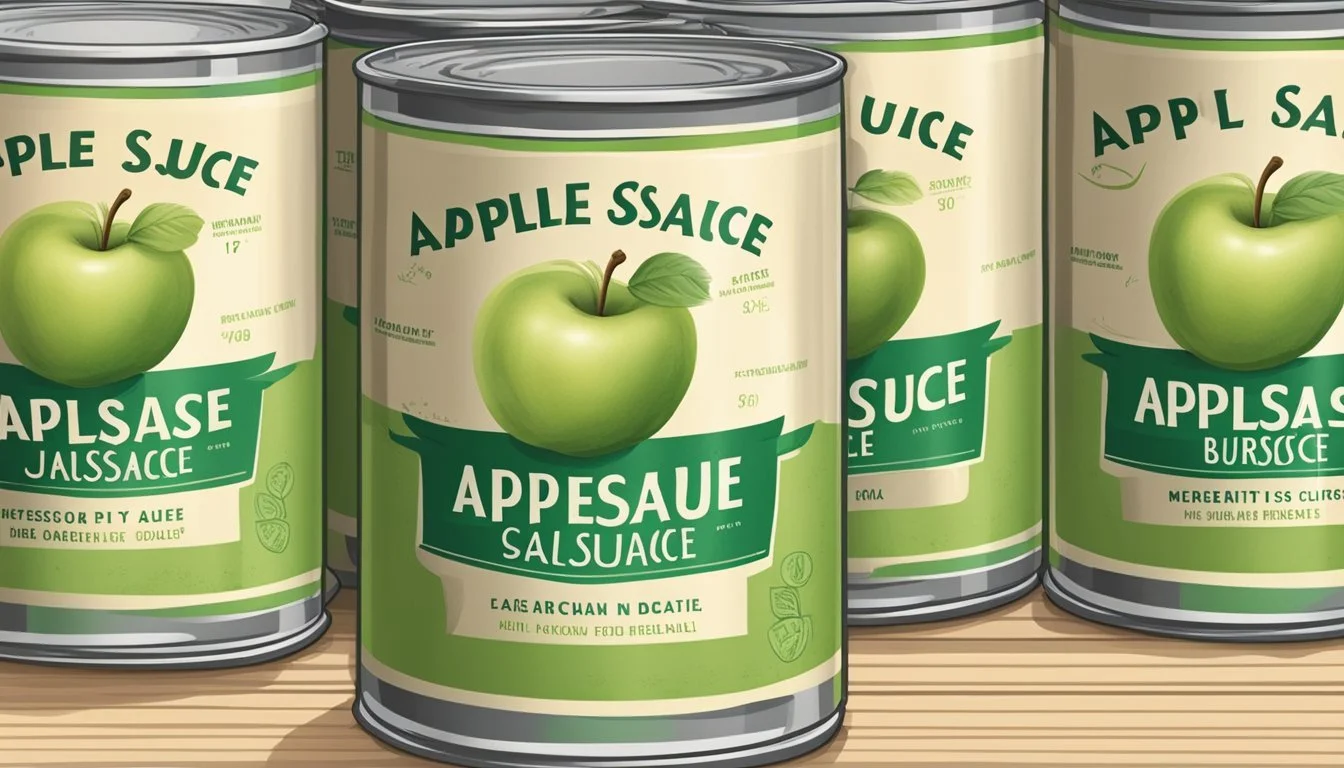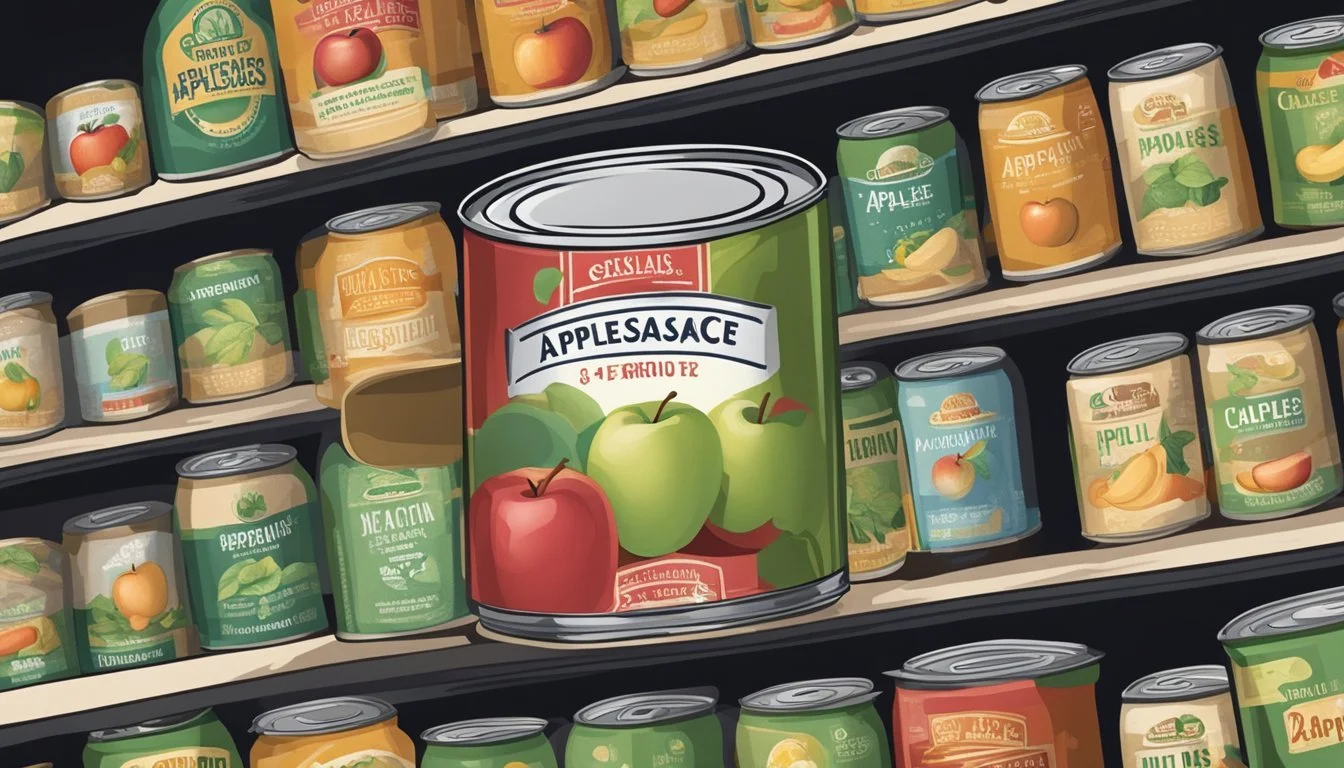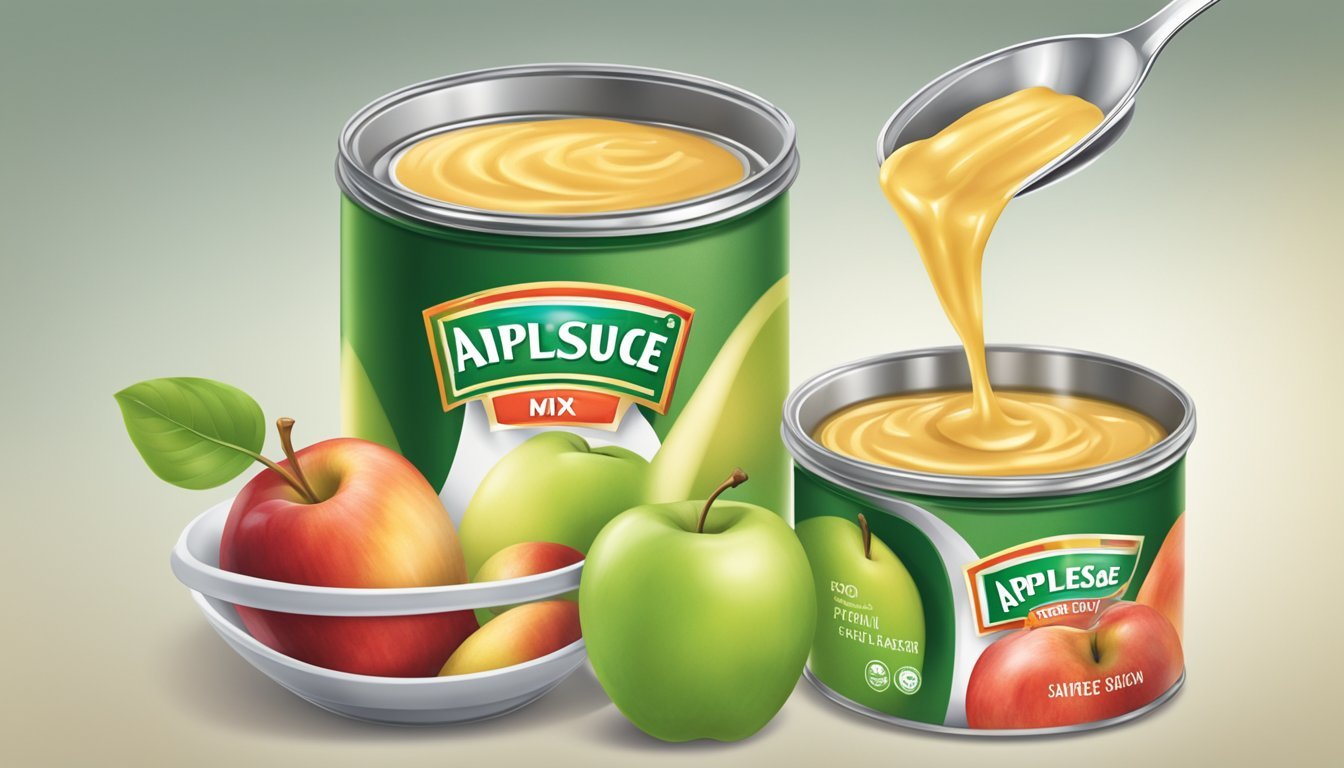Does Canned Applesauce Go Bad?
Shelf Life and Storage Tips
Canned applesauce is a convenient and delicious pantry staple, but knowing its shelf life is crucial for maintaining food safety. Canned applesauce can last between 12-18 months when stored in a cool, dark place, adhering to its best-by date. Once opened, it's essential to transfer the applesauce to an airtight container and refrigerate it, where it should be consumed within 3-4 days to ensure it remains safe to eat.
For those looking to extend the life of their applesauce further, freezing is an excellent option. Properly stored frozen applesauce can maintain its quality for up to a year. Always check the quality of applesauce by inspecting its appearance and smell, as consuming spoiled applesauce can lead to serious illness.
Proper storage practices can significantly affect the shelf life of canned applesauce. By keeping it in optimal conditions and following recommended guidelines, you can enjoy this versatile product safely for an extended period. Dive into more tips and advice on how to ensure your applesauce stays fresh and tasty.
Understanding Applesauce Shelf Life
Applesauce, whether store-bought or homemade, has a varied shelf life depending on its state—unopened, opened, or homemade. Proper storage significantly impacts how long it remains safe and tasty.
Unopened Applesauce
Unopened canned applesauce can last for 1-2 years past its production date. The key to prolonging its shelf life is keeping it in a cool, dark place. Store-bought applesauce has preservatives that help extend its life more than homemade varieties. Always check the expiration date on the packaging.
Vacuum-sealed jars provide an airtight environment that minimizes spoilage. Look for signs of damage or swelling on the container, which can indicate compromised safety.
Opened Applesauce
Once opened, applesauce should be refrigerated. Store it in an airtight container to prevent contamination and flavor loss. Opened store-bought applesauce typically lasts for about 7-10 days in the refrigerator. Always use clean utensils to avoid introducing bacteria.
Monitor for changes in smell, appearance, or texture. An off-odor, mold, or discoloration are signs that the applesauce should be discarded. Keeping it at a consistent, cold temperature helps maintain its quality.
Homemade Applesauce
Homemade applesauce lacks the preservatives found in commercial products, so its shelf life is shorter. It generally lasts 7-10 days if stored in the refrigerator in a sealed container. To extend its life, freezing is a good option.
Frozen homemade applesauce can last up to a year if properly stored in freezer bags or airtight containers. Always label with the freezing date. Signs of spoilage include an off-odor, unusual texture, and color changes.
Signs of Spoilage in Applesauce
Identifying when applesauce has gone bad is essential to avoiding food poisoning and ensuring safe consumption. Key indicators include changes in visual appearance, odor, flavor, and texture.
Visual Clues
Visual signs are often the first noticeable indicators of spoiled applesauce. Mold growth is a significant red flag. If you see mold on the surface or around the lid, discard the product immediately to prevent ingestion of harmful microorganisms.
Color changes are another clue. Fresh applesauce has a consistent, light hue, while spoiled applesauce may develop a darker color or uneven tones, indicating oxidation or other spoilage. Any presence of bubbles can also indicate fermentation, which means the applesauce has gone bad and should be discarded.
Odor and Flavor
Changes in smell and taste are critical for assessing spoilage. Fresh applesauce should have a pleasant, fruity aroma. Spoiled applesauce, however, may emit a sour or off-putting smell. This indicates microbial activity, which can lead to food poisoning if consumed.
When tasting applesauce, note any unnatural or sour flavors. A fresh product should taste sweet and fruity, while spoiled applesauce may have a bitterness or sourness that signals degradation. If in doubt, it's safest to avoid tasting suspect applesauce and rely on other spoilage indicators.
Texture Changes
Texture provides another important spoilage clue. Fresh applesauce has a consistent, smooth texture. Spoiled applesauce, by contrast, may become grainy, watery, or unusually thick. Separation is another signal; if the liquid separates from the pulp, this often points to fermentation or bacterial growth.
Feeling sliminess is also a clear sign that the applesauce has gone bad. If you observe any of these texture changes, it's best to be cautious and discard the applesauce to avoid potential health risks.
Proper Storage Practices
Proper storage of canned applesauce ensures it retains its quality and safety for consumption. Key practices include storing unopened cans in a cool, dark place, refrigerating opened cans, and considering freezing as an extended preservation method.
Storing Unopened Applesauce
Unopened canned applesauce should be stored in a cool, dark place, such as a pantry or cabinet. Exposure to direct light and heat can compromise the integrity of the can and the quality of the applesauce inside.
A dark, dry place helps maintain its flavor and nutritional value. Optimal storage conditions help unopened canned applesauce last 1-2 years past its production date.
Keeping the storage area free from moisture is crucial, as moisture can cause rust on cans. Rust can lead to contamination or spoilage, which compromises food safety. Consistent temperatures below 75°F (24°C) are recommended.
Refrigeration of Opened Applesauce
Once opened, canned applesauce should be refrigerated immediately. Transfer the applesauce to an airtight container to preserve its freshness and prevent contamination.
Refrigeration helps extend the shelf life, typically allowing the applesauce to stay safe and tasty for up to 3-4 days. Using an airtight container prevents the applesauce from absorbing odors from other foods.
Proper sealing is critical to maintaining food safety. Always check for off smells or changes in texture before consuming. Keeping the refrigerator at a consistent temperature of 40°F (4°C) or lower is essential for optimal storage.
Freezing Techniques for Applesauce
Freezing is an effective way to extend the shelf life of applesauce. It can be stored in freezer-safe containers or heavy-duty freezer bags.
To freeze, pour the applesauce into containers, leaving some headspace as it will expand. Labeling the containers with the date helps keep track of storage times. Applesauce can be safely frozen for 8-12 months without significant loss of quality.
When ready to use, thaw applesauce in the refrigerator or under running cold water. This method ensures a gradual temperature change that preserves texture and flavor. Always use freezer-safe containers to prevent freezer burn and maintain the applesauce's quality.
Expanding Applesauce Usage
Applesauce is a highly versatile ingredient that can be utilized in various culinary and daily applications. From enhancing the flavor of baked goods to creating healthy beverages, the uses for applesauce are plentiful and practical.
Cooking and Baking
Applesauce is a popular substitute for oil or butter in baking recipes. It can add moisture and a slight sweetness to items like pancakes, muffins, and cakes, making them healthier by reducing fat content.
In savory dishes, applesauce can be used to glaze meats such as pork or chicken, providing a sweet and tangy flavor.
It is also common in making quick bread and as a base for certain desserts, like applesauce pudding or spice cake.
Smoothies and Beverages
In smoothies, applesauce is an excellent sweetener and thickener. It blends well with other fruits, adding a smooth texture and slight sweetness without the need for added sugar.
Applesauce can also be mixed with water or juice to create a refreshing drink.
Adding applesauce to yogurt or oatmeal can create a nutritious breakfast or snack, enhancing both flavor and nutritional value.
Alternative Uses
Aside from cooking and smoothies, applesauce has several other applications. It can be used as a natural sweetener in various recipes, replacing refined sugars.
For those with dietary restrictions, applesauce serves as a great egg replacement in vegan recipes.
Additionally, it can be used to make homemade sauces or dressings, providing a unique twist to traditional recipes.
Whether used as a marinade for meats or a simple snack on its own, applesauce is both practical and delightful.
Handling and Preparing Applesauce
Proper handling and preparation of applesauce ensure it remains fresh and enjoyable. Key tasks include thawing frozen applesauce and mixing it correctly for serving.
Thawing Frozen Applesauce
Thawing frozen applesauce should be done in the refrigerator to maintain its quality. Place the container in the refrigerator for several hours or overnight. If quicker defrosting is needed, use a bowl of cold water, ensuring the container is sealed tightly to prevent water from seeping in.
Once thawed, inspect the applesauce for any changes in consistency. Stir it well to homogenize before serving. It's important to consume thawed applesauce within a few days, keeping it refrigerated to avoid spoilage.
Mixing and Serving
When preparing applesauce for serving, stir the sauce thoroughly. This helps in achieving a smooth and consistent texture. If applesauce has been stored for an extended period, it might need a brief stirring or light mashing to restore its original consistency.
Serve applesauce chilled or at room temperature. For added flavor, consider mixing in spices like cinnamon or nutmeg. Leftover applesauce can be refrigerated, ensuring it is tightly sealed to prevent air exposure and keep it fresh.
Safety and Health Considerations
Canned applesauce can spoil over time, posing health risks if consumed. It is crucial to identify when applesauce should be discarded and understand the potential health implications of eating spoiled food.
When to Discard Applesauce
Discarding applesauce is necessary when signs of spoilage are present. These signs include off-smell, unusual color changes, or mold growth. Unopened canned applesauce typically remains safe for 1-2 years beyond the production date if stored in cool, dark conditions.
Once opened, applesauce should be refrigerated and consumed within 7-10 days. Inspect the container for bulging lids or rust, which may indicate bacterial growth. Always check the expiration date and quality before consuming.
Health Implications of Spoiled Food
Eating spoiled applesauce can lead to food poisoning. Symptoms include nausea, vomiting, diarrhea, and abdominal pain. Consuming products past their expiration date, especially if improperly stored, increases the risk.
Infants, elderly individuals, and those with weakened immune systems are especially vulnerable. Spoiled food may harbor pathogens such as Clostridium botulinum or Listeria, which can cause severe illness. Ensuring good food safety practices, such as inspecting the food's condition and adhering to storage guidelines, is crucial in preventing health risks.
Maximizing Your Applesauce's Potential
Storing applesauce correctly and incorporating it into various recipes can enhance its longevity and versatility. By following specific guidelines, you can make the most out of your canned applesauce.
Shelf Optimization
Proper storage is crucial for extending the shelf life of applesauce. Unopened canned applesauce should be kept in a cool, dark place, away from direct light and heat sources.
Once opened, it must be transferred to an airtight container and refrigerated, where it will stay fresh for up to 3-4 days.
For longer storage, freezing is an effective method. Ensure the applesauce is placed in an airtight container or freezer bag, leaving some space for expansion. Frozen applesauce can last up to 3 months while maintaining its quality.
Creative Recipes
Using applesauce creatively can prevent waste and add variety to meals. It serves as a healthy substitute for oil or butter in baking, adding moisture without excess fat.
Try incorporating applesauce in smoothies for a natural sweetness and nutritional boost.
You can also make applesauce pancakes or muffins, offering a delicious twist on breakfast classics. For savory options, mix applesauce with spices to create a glaze for meats or a flavorful addition to sauces.
Experimenting with these recipes not only maximizes the use of your applesauce but also adds a diverse range of dishes to your culinary repertoire.







